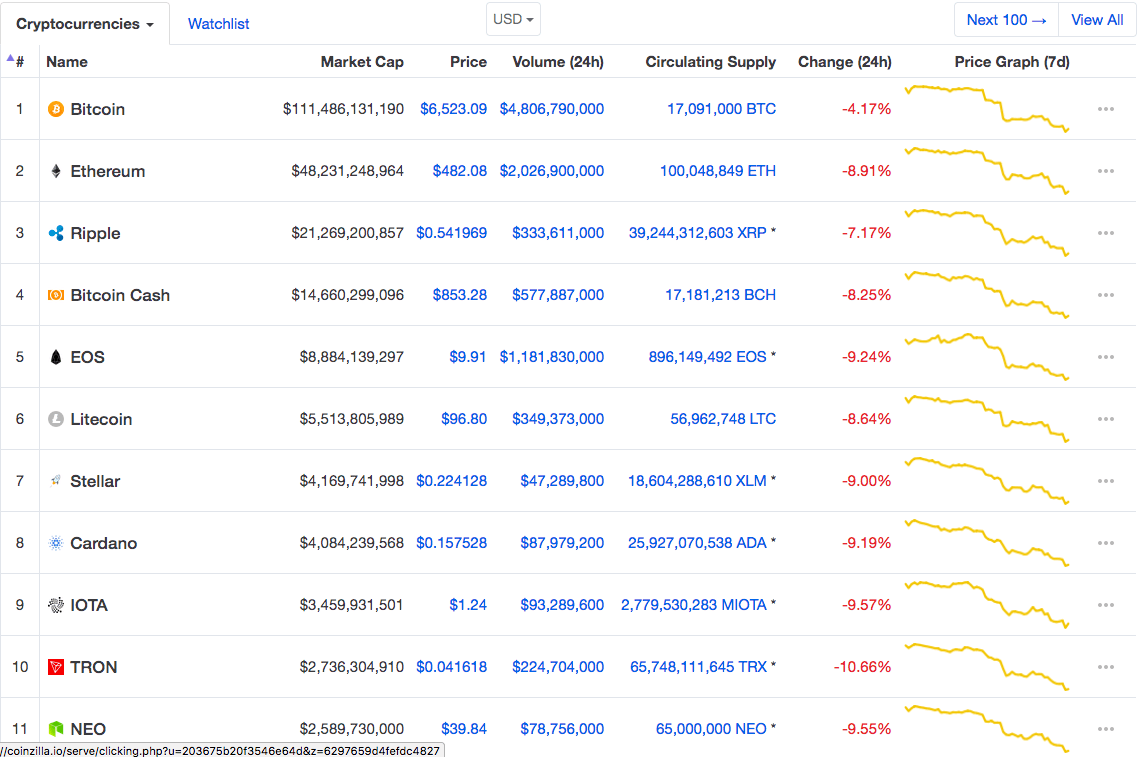
The cryptocurrency market is hitting the skids. Bitcoin has hit its lowest since February and Litecoin has crossed below $100 for the first time this year.
Cryptocurrency analysts have unanimously suggested that the price drop has something to do with the Coinrail hacking. But, the hacking didn’t have anything to do with Bitcoin, Litecoin, or most of the other 1600 odd cryptocurrencies listed on CoinMarketCap. So, why is the entire market down? The recent movements are again highlighting the phenomena of cross-coin price correlation.
Look at the price movement of the top 11 cryptocurrencies over the last week, for example. They all seem to follow the same pattern:

It’s not just the top 11 cryptocurrencies either, the graph is more or less same for all the currencies listed on CoinMarketCap bar a few, such as Tether and Ethereum Classic.
Tether is a USD-pegged cryptocurrency, which makes it less volatile than other cryptocurrencies, and Ethereum Classic recently got listed on Coinbase bringing a surge in its market price. So, bar these special circumstances, all coins are moving in correlation.
The fact that the rest of the market is affected by movements in the price of Bitcoin is a long-discussed phenomena. But, the price movement following Coinrail hack shows that it is not just true for Bitcoin — other incidents also seem to be triggering a mass change in the market.
Cryptocurrency trading analyst, Cryptorae, explains in a Twitter thread, that correlation measures the degree to which the coins move in tandem with each other. A correlation of zero implies that the two cryptocurrencies are not moving similarly at all, and a correlation of one (maximum) will imply that the fluctuations in the set of coins together and any individual coins have become indistinguishable from each other.
You calculate CCC by averaging the correlation for every coin pair in a set. The benefit of using CCC is that it provides a clean line that describes how markets have behaved in over time. Here's the cross-correlation for 25 mid-to-large cap coins (30D rolling, realized). pic.twitter.com/pxw0rJhbxB
— cryptorae (@cryptorae) June 3, 2018
Cryptorae points out that correlation was zero in November 2017, but has been increasing constantly since February, and currently stands at a ‘ridiculously high’ 0.85.
This leads him to conclude that the market is largely driven by fear and speculation above anything else. The only way to diversify your portfolio in situations like this is to look towards non-cryptocurrency assets.
Cryptocurrency investor, Ari Paul, further reiterated on Cryptorae’s stance, but said that correlations are calculated based on past data. In volatile markets such as cryptocurrency, things change fast, and currencies which are moving in correlation now may not move in correlation in the future.
4/ A common mistake is to view correlation as binary (are the assets correlated or not?) But you get diversification benefit even if the assets are 90% correlated…just less of a benefit. The greatest benefits occur with negative correlations which are very hard to find.
— Ari Paul (@AriDavidPaul) June 3, 2018
Irrespective of that, Paul still believes that most cryptocurrencies are bad investments and there is little benefit to diversifying your portfolio.
“If you have a portfolio with 50 assets, but they’re all ERC20 tokens, you’re 100 percent concentrated along the protocol risk axis. A fundamental bug in Ethereum might destroy your whole portfolio,” Paul argues. “Other regimes to think about are decentralized application (DApp) platforms falling out of favor, privacy coins becoming unpopular or facing regulatory pressure, decentralized exchanges (DEXs), directed acyclic graphs (DAGs), or other ‘groups’ of coins that may suffer similar fates for a variety of fundamental or psychological reasons.”
If the currencies are, in fact, moving in correlation, diversifying the portfolio won’t actually help cryptocurrency traders hedge investment risk. So, what’s the solution?
Paul argues that there are very few cryptocurrency projects that are, in fact, good. It is better to select a few cryptocurrencies that you truly believe will pay out in long term and concentrate your investment there, instead of diversifying your portfolio to 100 cryptocurrencies.
Get the TNW newsletter
Get the most important tech news in your inbox each week.





